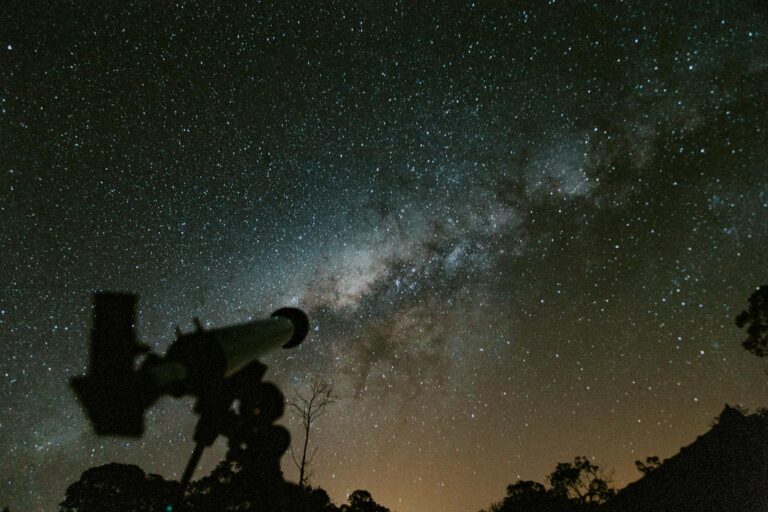Interstellar Visitors Science Uncovers Cosmic Breakthroughs
Beyond Our Solar System: How Cutting-Edge Science Coverage Explores the Biggest Breakthroughs from Interstellar Visitors
Estimated reading time: Approximately 21 minutes
Key Takeaways
- NASA mounted an unprecedented, coordinated effort using ground-based and space-based telescopes (e.g., Hubble, JWST, VLT) to observe interstellar comet 3I/ATLAS, capturing critical data about its composition and behavior.
- Interstellar objects like 3I/ATLAS serve as invaluable “time capsules” from other star systems, offering direct insights into the diverse chemical compositions and planet-forming conditions beyond our own solar system.
- The complex scientific and logistical challenges of observing 3I/ATLAS drive significant technological advancements in fields such as advanced sensors, AI/ML for anomaly detection and data analysis, and high-performance computing, with broad applications across various industries.
- This interstellar pursuit highlights the critical importance of global collaboration, strategic long-term vision in R&D, and data-driven decision-making, providing essential lessons for business leaders and innovators.
- Future observatories, such as the Vera C. Rubin Observatory, are poised to dramatically increase ISO detection rates, laying the groundwork for ambitious “Project Lyra”-like missions aimed at intercepting and studying these cosmic visitors up close.
Table of Contents
- Introduction: When the Universe Visits – Unpacking the Significance of Interstellar Object 3I/ATLAS
- The Ghostly Messenger: What is 3I/ATLAS and Why Is It So Special?
- NASA’s All-Out Pursuit: “Virtually Everything” Explained
- Unveiling the “Ghostly Beauty”: What the Images Tell Us
- Why Interstellar Discoveries Matter for Business Professionals
- The Future of Interstellar Exploration: From Observation to Interception?
- FAQs about Interstellar Object 3I/ATLAS and Space Discoveries
- Conclusion: The Unending Journey of Science Coverage
Introduction: When the Universe Visits – Unpacking the Significance of Interstellar Object 3I/ATLAS
Imagine a traveler from a distant, unseen star system, hurtling through the vast emptiness of space for eons, only to make a brief, spectacular appearance in our cosmic neighborhood. Such an event is not science fiction; it’s the extraordinary reality brought to us by objects like 3I/ATLAS, an interstellar comet that recently captivated the scientific community. In a demonstration of unparalleled scientific collaboration and technological prowess, NASA reportedly “threw virtually everything it’s got” at this fleeting visitor, capturing never-before-seen images of its ghostly beauty. This incredible feat is a testament to why science coverage explores the biggest breakthroughs and strangest discoveries across space, physics, biology, archaeology, health, and beyond, providing not just wonder, but also profound insights into the universe’s workings.
For business professionals, entrepreneurs, and tech-forward leaders, such astronomical achievements might seem far removed from quarterly reports or market trends. However, the pursuit of these distant discoveries drives incredible innovation in data science, sensor technology, computational modeling, and global collaboration – all areas with direct implications for modern enterprise. The story of 3I/ATLAS is more than just a celestial spectacle; it’s a narrative of humanity’s insatiable curiosity, our technological reach, and the collaborative spirit that pushes the boundaries of knowledge. It offers a unique lens through which to understand the pace of innovation, the power of data, and the strategic importance of long-term vision.
Join us as we delve into the mystery of 3I/ATLAS, explore the sophisticated scientific endeavor behind its observation, and uncover why these cosmic encounters are not just fascinating headlines, but crucial milestones in our collective journey of discovery.
The Ghostly Messenger: What is 3I/ATLAS and Why Is It So Special?
The universe is vast, and our solar system is but a tiny speck within it. For millennia, humanity assumed that everything we observed in the night sky was gravitationally bound to our Sun. This perception began to change dramatically with the detection of the first confirmed interstellar object, ‘Oumuamua, in 2017. Its bizarre, elongated shape and peculiar trajectory immediately signaled that it was unlike any asteroid or comet we had ever encountered. Then came 2I/Borisov in 2019, the first interstellar comet. And now, 3I/ATLAS, continuing to expand our understanding of what lies beyond our stellar doorstep.
A Rare Glimpse from Another Star System
An interstellar object (ISO) is, quite simply, an object that originated from outside our solar system and is merely passing through, not gravitationally bound to our Sun. The “I” in 3I/ATLAS stands for “interstellar,” distinguishing it from objects originating within our own solar system. Its “3” designation indicates it is the third such confirmed interstellar object to be given a formal designation.
Detecting such objects is incredibly challenging. They are typically small, move very quickly relative to our solar system’s fixed background, and are only observable when they happen to pass close enough to the Sun to become illuminated, or close enough to Earth to be within the detection range of our most powerful telescopes. Their trajectories are hyperbolic, meaning they approach our Sun, are flung around it, and then head back out into interstellar space, never to return. This brief window of opportunity demands rapid response and exceptional coordination from astronomers worldwide.
Unlike homegrown comets that spend millennia in the frigid outer reaches of our solar system (like the Oort Cloud) before venturing inwards, interstellar visitors carry with them the pristine material of a different stellar nursery. They are time capsules, not of our past, but of another star’s formation and evolution.
The Cometary Difference: More Than Just a Rock
While ‘Oumuamua was an enigmatic, rocky object, 3I/ATLAS is definitively a comet. This distinction is crucial. Comets are essentially “dirty snowballs” – cosmic icebergs composed of frozen gases, dust, and rock. As they approach a star, the ice begins to sublimate (turn directly into gas), creating a glowing atmosphere (coma) and often a magnificent tail of gas and dust pushed away by stellar wind and radiation.
The cometary nature of 3I/ATLAS is immensely significant for several reasons:
- Volatile Composition: Comets are rich in volatile materials like water ice, carbon monoxide, methane, and various organic compounds. These are the building blocks of planets and, potentially, life. Analyzing the specific mix of volatiles in 3I/ATLAS can provide a direct chemical fingerprint of the conditions present in its parent star system’s protoplanetary disk.
- Clues to Exoplanetary Systems: By studying an interstellar comet, scientists gain a tangible sample of material from another star system, allowing for direct comparison with our own solar system’s composition. Is water as abundant elsewhere? Are the organic molecules similar? This helps us understand the commonalities and differences in planet formation across the galaxy.
- Dynamic Processes: The formation of a comet’s coma and tail also provides insights into its internal structure and how it reacts to stellar radiation – information valuable for understanding comets in general, both local and interstellar.
The “ghostly beauty” mentioned in the research summary likely refers to these very features: the ethereal glow of its coma, the elegant sweep of its tail, and the mysterious, fleeting presence it commands against the backdrop of distant stars. These images are not just aesthetically pleasing; they are rich datasets waiting to be deciphered.
NASA’s All-Out Pursuit: “Virtually Everything” Explained
When the research states that NASA “threw virtually everything it’s got” at 3I/ATLAS, it signifies an extraordinary, coordinated scientific effort rarely seen outside of major, planned missions. Observing a fast-moving, relatively faint object from another star system is a monumental task, demanding the best of humanity’s astronomical infrastructure and intellectual capital.
A Symphony of Observatories: Ground-Based and Space-Based Assets
Capturing detailed images and data from 3I/ATLAS required a multi-pronged approach, leveraging a diverse array of observational instruments. Each telescope and observatory offers unique capabilities, from different wavelengths of light to varying resolutions and fields of view.
Space-Based Telescopes:
- These are often the first line of defense for high-resolution imaging and observations free from Earth’s atmospheric interference.
- Hubble Space Telescope (HST): The venerable HST, with its unparalleled optical and ultraviolet capabilities, would have been crucial for capturing sharp images, tracking subtle changes in the comet’s morphology, and potentially conducting spectroscopy in visible and UV light to identify gas compositions.
- James Webb Space Telescope (JWST): As the premier infrared observatory, JWST would be indispensable for detecting the cooler gases and dust within the comet’s coma and tail that are invisible to optical telescopes. Infrared spectroscopy is particularly powerful for identifying specific molecules like water, carbon dioxide, methane, and various silicates, providing a much deeper understanding of the comet’s chemical makeup.
- Other Potential Space Assets: Depending on its trajectory and timing, other spacecraft designed for solar observation (like STEREO) or general sky surveys could have contributed to its detection or initial tracking, providing context or early warnings.
Ground-Based Observatories:
- Despite atmospheric blurring, ground-based telescopes offer sheer aperture size, advanced adaptive optics, and the flexibility of being controlled by astronomers directly.
- Very Large Telescope (VLT – Chile): One of the world’s most advanced optical telescopes, capable of high-resolution imaging and powerful spectroscopy. Its multiple 8.2-meter telescopes can work together as an interferometer.
- Keck Observatory (Hawaii): With twin 10-meter telescopes, Keck is renowned for its adaptive optics system, which compensates for atmospheric distortions, delivering incredibly sharp images and spectroscopic data.
- Gemini Observatory (Hawaii & Chile): Two 8.1-meter telescopes providing full sky coverage, excellent for both imaging and spectroscopy.
- Pan-STARRS (Hawaii) and ATLAS (Hawaii): These wide-field survey telescopes are often the first to detect fast-moving objects, scanning large portions of the sky nightly. Their data is crucial for initial trajectory calculations and alerts.
- Other Large Observatories: Facilities like the Gran Telescopio Canarias, Subaru Telescope, and numerous smaller university-run telescopes would also be pressed into service, each adding to the collective data pool.
The coordination of these disparate assets, often operated by different agencies and nations, represents a monumental logistical and scientific challenge. It requires rapid communication, dynamic scheduling of precious telescope time, and a unified strategy to maximize data acquisition during the fleeting window of opportunity.
The Science of Swift Observation: Predictive Trajectories and Dynamic Scheduling
Tracking an interstellar object is far more complex than tracking a known asteroid or a periodic comet within our solar system. Interstellar objects follow hyperbolic paths, meaning their gravitational interaction with the Sun is a single, dramatic slingshot maneuver. Their initial trajectory is often poorly constrained, necessitating sophisticated astrometry and orbital mechanics to refine their path.
- Astrometry and Orbital Mechanics: Initial observations from survey telescopes provide rough positions and velocities. These data points are then fed into complex computational models to predict the object’s future path. As more observations come in, the trajectory is refined, allowing astronomers to accurately point high-resolution telescopes. The ability to quickly process this data and update predictions is paramount.
- Dynamic Scheduling: Major observatories plan their observing schedules months, if not years, in advance. Interrupting these schedules for an unexpected, time-sensitive event like 3I/ATLAS requires immense flexibility and cooperation from telescope committees and individual researchers. It speaks to the perceived scientific value of these objects that such disruptions are not only permitted but actively encouraged.
- Big Data and AI/ML in Astronomy: The process of detecting, tracking, and analyzing data from such an event is a prime example of how big data and advanced computational methods are transforming astronomy.
- Automated Detection: Wide-field surveys rely heavily on AI/ML algorithms to automatically scan millions of astronomical images for anomalies – objects that move against the background of stars, or objects with unusual light curves. These systems generate alerts that trigger human follow-up.
- Trajectory Optimization: AI can assist in optimizing observation strategies, determining the best sequence of telescopes and observation times to maximize data yield, given the object’s predicted path and the unique capabilities of each instrument.
- Data Analysis: Once data is collected, AI/ML tools can help in processing vast quantities of raw images and spectra, identifying subtle features, classifying materials, and even reconstructing 3D models of the comet’s nucleus or coma structure from multiple angles. This accelerates discovery from raw data to scientific insight.
The successful observation of 3I/ATLAS is a testament to not only the hardware but also the software and human ingenuity that orchestrates these complex scientific endeavors.
Unveiling the “Ghostly Beauty”: What the Images Tell Us
The phrase “ghostly beauty” perfectly encapsulates the allure and mystery of an interstellar comet. These aren’t just pretty pictures; they are invaluable scientific documents, each pixel packed with potential revelations about the composition, structure, and origin of 3I/ATLAS. Through sophisticated analysis, scientists can extract an incredible amount of information.
Peering into an Alien Past
The images captured by NASA’s armada of telescopes allow astronomers to make precise measurements and inferences about 3I/ATLAS:
- Size and Shape: By analyzing its brightness and how it changes over time (light curve), scientists can estimate the size and potentially even the irregular shape of its nucleus. Irregular shapes can hint at its formation history or past collisions.
- Rotation: Changes in brightness can also indicate if the comet is rotating and, if so, its rotation period. This affects how volatiles are released and how the tail forms.
- Coma and Tail Structure: The morphology of the coma (the gas cloud surrounding the nucleus) and the tail(s) provides clues about the rate of sublimation, the types of gases being released, and the influence of solar radiation and solar wind. Multiple tails, for instance, can indicate different particle sizes or compositions.
- Compositional Analysis (Spectroscopy): While the summary mentions “images,” it’s highly probable that spectroscopic data was also gathered. Spectroscopy involves breaking down the light from the comet into its constituent wavelengths, much like a prism separates white light into a rainbow. Each element and molecule emits or absorbs light at specific wavelengths, creating a unique “fingerprint.”
- By analyzing the spectrum of 3I/ATLAS, scientists can identify the specific frozen gases (e.g., water, CO, CO2, methane) and dust particles (e.g., silicates, organic compounds) that make up the comet. This is the holy grail of ISO studies – direct chemical sampling of another star system.
- Activity Levels: How active is the comet? How much gas and dust is it shedding? This provides insights into its ice content and how it responds to warming by our Sun, giving clues about the environment it experienced in its home system.
The “ghostly beauty” thus transforms from a mere visual spectacle into a detailed scientific blueprint of a celestial wanderer, allowing us to peer directly into the physical and chemical conditions of a different stellar nursery.
Understanding Exoplanetary Formation
The greatest scientific payoff from studying interstellar objects like 3I/ATLAS lies in what they tell us about exoplanetary systems – planets orbiting other stars. Before ISOs, our only “samples” of exoplanetary material were indirect, through observing the light from exoplanet atmospheres or the faint dust disks around other stars. 3I/ATLAS offers a direct, albeit small, piece of another star system.
- Building Blocks of Planets: The composition of a comet reflects the raw materials available in the protoplanetary disk from which its star system’s planets formed. If 3I/ATLAS is rich in water and organic molecules, it suggests that its home system had abundant ingredients for potentially habitable planets.
- Comparative Planetology: By comparing the composition of 3I/ATLAS to comets in our own solar system, scientists can identify similarities and differences. Are the chemical ratios universal, or does each star system have its own unique recipe? This helps refine our models of planet formation, making them more robust and globally applicable.
- Diversity of Solar Systems: Every ISO is a unique window into the sheer diversity of star systems in the galaxy. Some might have been ejected from systems vastly different from our own, perhaps around red dwarfs, binary stars, or even neutron stars, carrying with them unique chemical signatures.
The Quest for Extraterrestrial Life: A Subtle Connection
While 3I/ATLAS is certainly not an alien spacecraft or a direct carrier of life, its study subtly contributes to humanity’s enduring quest for extraterrestrial life.
- Panspermia Hypothesis: One theory suggests that life, or the building blocks of life, could be transported between star systems via objects like comets and asteroids. If 3I/ATLAS is found to contain complex organic molecules, or even amino acids (the fundamental components of proteins), it strengthens the idea that these vital ingredients are widespread in the galaxy and can survive interstellar journeys.
- Habitable Ingredients: Understanding the prevalence of water and organic compounds in other star systems helps constrain the probability of life arising elsewhere. If these essential ingredients are commonly incorporated into planet-forming material and subsequently ejected as comets, it increases the cosmic likelihood of life’s emergence.
Thus, the “ghostly beauty” of 3I/ATLAS is not merely an aesthetic marvel, but a profound data source, illuminating the processes of star and planet formation and subtly informing our search for life beyond Earth.
Why Interstellar Discoveries Matter for Business Professionals
At first glance, the study of interstellar comets might seem like an abstract academic pursuit, far removed from the tangible concerns of the business world. However, the groundbreaking science behind observing 3I/ATLAS holds profound lessons and direct implications for entrepreneurs, tech leaders, and strategic decision-makers across various industries. These scientific endeavors are not just about discovery; they are about pushing the boundaries of technology, fostering innovation, and managing complex, data-intensive projects on a global scale.
Fostering Innovation and Technological Advancement
The challenges of detecting, tracking, and analyzing a faint, fast-moving object from another star system drive the development of cutting-edge technologies that inevitably find applications far beyond astronomy.
- Advanced Sensors and Optics: The demand for ever-more sensitive detectors, higher-resolution cameras, and adaptive optics systems (which correct for atmospheric distortions) pushes the envelope in material science, microelectronics, and optical engineering. These advancements have direct applications in medical imaging, remote sensing (e.g., satellite imagery for agriculture, urban planning), defense, and industrial quality control.
- Computational Power and AI/ML: As discussed, identifying anomalies in vast datasets, predicting trajectories, and processing complex spectroscopic information relies heavily on high-performance computing, sophisticated algorithms, and artificial intelligence.
- AI for Anomaly Detection: The same AI systems that flag unusual celestial objects can be adapted for fraud detection in finance, cybersecurity threat analysis, predictive maintenance in manufacturing, or identifying anomalies in health data.
- Data Visualization and Analysis: Tools developed to make sense of astronomical data can be adapted for business intelligence, market trend analysis, and complex simulations.
- Materials Science: The extreme environments of space demand materials that are lightweight, durable, radiation-hardened, and capable of operating at cryogenic temperatures. Innovations in these areas benefit aerospace, automotive, and electronics industries.
- Propulsion Systems: While not directly used for observing 3I/ATLAS, the long-term goal of intercepting an ISO drives research into advanced propulsion (e.g., solar sails, ion engines) – technologies crucial for future space commerce and exploration.
Investing in and supporting scientific research, even “blue sky” projects, creates a powerful ecosystem of innovation that delivers tangible returns through technological spin-offs and a more skilled workforce.
Data-Driven Decision Making at Scale
The observation campaign for 3I/ATLAS is a masterclass in managing “big data” and making rapid, critical decisions under immense uncertainty.
- Real-time Analytics: The ability to process data from multiple sources (telescopes) in near real-time, update predictive models, and adjust observation strategies exemplifies the power of dynamic data analytics. Businesses can learn from this in areas requiring rapid response, such as supply chain management, financial trading, or disaster response.
- Data Integration and Interoperability: Integrating data from diverse instruments, often with different formats and protocols, mirrors the challenges faced by enterprises seeking to consolidate information from various departments, legacy systems, or external partners.
- Risk Management and Resource Allocation: Deciding which telescope to use, when, and for how long, given limited resources and a fleeting opportunity, is a high-stakes resource allocation problem. This parallels strategic planning in business, where leaders must weigh potential returns against costs and risks, making informed decisions with incomplete information.
- The Value of Data Literacy: For leaders, understanding how data is collected, analyzed, and interpreted (and its limitations) is critical. Scientific endeavors like this highlight the need for data literacy across an organization, enabling better communication between technical teams and leadership.
Strategic Foresight and Global Collaboration
Large-scale scientific projects are inherently collaborative and demand a long-term vision.
- Global Collaboration: Observing 3I/ATLAS required seamless cooperation between international space agencies, research institutions, and individual astronomers across different continents and time zones. This exemplifies successful global collaboration, a model for multinational corporations and international partnerships. It underscores the benefits of sharing resources, expertise, and a common goal.
- Long-Term Vision: The development of advanced telescopes like JWST represents decades of investment, planning, and perseverance. This long-term strategic thinking, focusing on foundational capabilities rather than immediate returns, is a crucial lesson for business leaders contemplating R&D investments or market diversification.
- Inspiring the Next Generation: The awe and wonder generated by discoveries like 3I/ATLAS are invaluable for inspiring students to pursue STEM careers. A skilled workforce in science, technology, engineering, and mathematics is the bedrock of future economic growth and innovation. Businesses have a vested interest in fostering this inspiration.
Expanding Our Worldview: The Intangible Benefits
Beyond the direct technological and operational lessons, interstellar discoveries offer intangible, yet profound, benefits:
- Challenging Assumptions: Encounters with objects like ‘Oumuamua and 3I/ATLAS force us to continually revise our understanding of the universe, challenging ingrained assumptions and opening new avenues of inquiry. This mindset of continuous questioning and adaptability is vital for businesses in a rapidly changing market.
- Promoting Curiosity: The intrinsic human curiosity about “what’s out there” is a powerful driver of progress. Nurturing this curiosity, both personally and within organizations, fuels creativity and a desire for continuous learning.
- Contextualizing Humanity: Seeing our solar system as part of a larger, dynamic galactic environment can offer a broader perspective on our place in the cosmos, potentially influencing how we approach environmental stewardship, international relations, and long-term societal goals.
Ultimately, the study of interstellar objects like 3I/ATLAS is not just about astronomy; it’s about pushing the frontiers of human capability, embracing complex challenges, and extracting valuable insights that resonate across diverse fields, from advanced technology to strategic leadership.
The Future of Interstellar Exploration: From Observation to Interception?
The successful observation of 3I/ATLAS marks another significant step in our understanding of interstellar objects. But this is merely the beginning. As technology continues to advance, our capabilities for detecting, characterizing, and potentially even interacting with these cosmic visitors will grow exponentially.
Next-Generation Telescopes and Surveys
The current generation of survey telescopes like Pan-STARRS and ATLAS has been instrumental in detecting ISOs. However, upcoming instruments promise to revolutionize our detection capabilities:
- Vera C. Rubin Observatory (formerly LSST): This facility, expected to achieve full operations in the coming years, will conduct an unprecedented wide-field survey of the entire observable sky every few nights. Its massive mirror and highly sensitive camera are specifically designed to detect faint, fast-moving objects. It is projected that the Rubin Observatory could discover several interstellar objects per year, transforming our current trickle of detections into a steady stream. This will allow for statistical studies of ISO populations, revealing their prevalence, size distribution, and typical compositions.
- Future Space Telescopes: While Hubble and JWST are already powerful, future space-based observatories might be designed with ISO detection or follow-up as a primary mission objective, offering even greater sensitivity and unique spectral ranges.
These next-generation instruments will not only increase the sheer number of detections but also provide earlier warning, allowing for more comprehensive observation campaigns than ever before possible.
Project Lyra and the Challenge of Rendezvous Missions
The ultimate dream for many scientists and engineers is not just to observe an interstellar object from afar, but to send a probe to intercept it. This is the ambitious goal of initiatives like “Project Lyra,” a conceptual study by the Initiative for Interstellar Studies (i4is).
- The Technological Hurdles: Intercepting an ISO presents formidable challenges:
- Speed: ISOs travel at incredible velocities – tens of kilometers per second relative to the Sun. Catching up to them requires propulsion systems far more powerful than what is typically used for planetary missions.
- Trajectory Prediction: Despite improved astrometry, predicting the precise trajectory years in advance for an intercept mission is incredibly difficult due to gravitational perturbations and the comet’s own outgassing.
- Response Time: A mission would need to launch within a very short window (months to a few years) of an ISO’s detection. This demands “ready-to-go” spacecraft and launch capabilities.
- Advanced Propulsion: To achieve the necessary speeds, concepts under consideration include:
- Solar Sails: Using the pressure of sunlight to accelerate a spacecraft.
- Electric Propulsion (Ion Thrusters): Providing continuous, low-thrust acceleration over long periods.
- Nuclear Propulsion: More powerful but technically and politically challenging.
- Laser Propulsion: Proposed for “Breakthrough Starshot,” involving powerful ground-based lasers pushing tiny probes to relativistic speeds.
- Scientific Payoff: A successful rendezvous mission would be revolutionary. A spacecraft could:
- Perform close-up imaging of the nucleus.
- Collect samples of dust and gas directly from the coma.
- Analyze surface composition with on-board instruments.
- Provide definitive answers about the object’s origin, composition, and potential for harboring pre-biotic molecules.
While still largely theoretical, the pursuit of intercepting an ISO is driving fundamental research in propulsion, autonomous navigation, and miniaturized instrumentation – technologies that will define future space exploration.
Cataloging the Cosmos: Building an Interstellar Inventory
The growing number of detected interstellar objects is beginning to form an “interstellar inventory.” Each new discovery adds to our nascent understanding of the population of objects roaming the galaxy.
- Statistical Analysis: As more ISOs are found, astronomers can begin to statistically analyze their characteristics: Are most rocky or icy? What are their typical sizes and speeds? Where do they seem to originate from (types of stars, regions of the galaxy)?
- Understanding Galactic Ecology: These objects are not just curiosities; they are fundamental components of the galactic ecosystem. They represent the material ejected from evolving star systems, enriching or altering the composition of other regions of the galaxy. Understanding them helps us paint a more complete picture of how the Milky Way itself evolves.
The journey of interstellar exploration has just begun. From the “ghostly beauty” captured by NASA’s unprecedented efforts with 3I/ATLAS, to the ambitious dreams of sending our own probes to greet future visitors, humanity’s curiosity about what lies beyond our stellar backyard continues to drive us forward, yielding not just scientific knowledge but also technological progress that resonates deeply within our terrestrial world.
FAQs about Interstellar Object 3I/ATLAS and Space Discoveries
Q1: What exactly is an interstellar object (ISO)?
An interstellar object (ISO) is an astronomical body, like an asteroid or a comet, that originates from outside our solar system and is merely passing through, not gravitationally bound to our Sun. It travels between star systems in interstellar space.
Q2: How do we know 3I/ATLAS came from another star system?
Astronomers determine an object’s origin by analyzing its trajectory. Objects bound to our Sun follow elliptical or parabolic orbits. Interstellar objects, however, follow hyperbolic trajectories, meaning they enter our solar system, are accelerated by the Sun’s gravity, and then leave, never to return. The speed and direction of 3I/ATLAS clearly indicate a hyperbolic path, confirming its interstellar origin.
Q3: What’s the difference between an interstellar asteroid and a comet?
The primary difference is their composition and behavior when near a star.
- Interstellar Asteroid: Like ‘Oumuamua, these are primarily rocky or metallic objects. They typically don’t develop a coma (atmosphere) or tail when approaching a star.
- Interstellar Comet: Like 3I/ATLAS and 2I/Borisov, these are rich in volatile ices (water, carbon monoxide, methane, etc.) mixed with dust. As they near a star, the ices sublimate, forming a glowing coma and a characteristic tail, making them much brighter and easier to observe.
Q4: What technologies did NASA use to observe 3I/ATLAS?
NASA, in collaboration with international partners, likely employed a wide array of advanced observatories, both space-based and ground-based. This would include:
- Space Telescopes: Hubble Space Telescope (for optical/UV imaging), James Webb Space Telescope (for infrared imaging and spectroscopy of cold gases/dust).
- Ground-Based Telescopes: Large optical/infrared observatories like the Very Large Telescope (VLT), Keck Observatory, and Gemini Observatory, equipped with adaptive optics for sharper images.
- Survey Telescopes: Wide-field systems like Pan-STARRS and ATLAS that scan the sky for new objects.
The combined power of these instruments allowed for comprehensive data collection across various wavelengths.
Q5: Why is it important to study objects like 3I/ATLAS?
Studying ISOs is crucial for several reasons:
- Exoplanetary Formation: They provide the only direct samples of material from other star systems, offering insights into the chemical conditions and building blocks of planets beyond our Sun.
- Diversity of Solar Systems: They help us understand if the processes of planet formation and the composition of stellar nurseries are universal or vary significantly across the galaxy.
- Understanding Our Own Solar System: By comparing ISOs to our own comets and asteroids, we gain a better context for our solar system’s origins and evolution.
- Technological Advancement: The challenge of observing these objects drives innovation in sensor technology, data processing (including AI/ML), and orbital mechanics.
Q6: Could 3I/ATLAS carry life or signs of life?
While fascinating, it’s highly improbable that 3I/ATLAS itself carries living organisms. The conditions in interstellar space are extremely harsh (radiation, vacuum, extreme cold), making survival difficult. However, it’s possible for comets to carry complex organic molecules – the pre-cursors to life – and some scientists speculate about the “panspermia” hypothesis, where these building blocks could be transported between star systems. Studying its composition could reveal if such molecules are present.
Q7: How frequently do interstellar objects visit our solar system?
Before ‘Oumuamua in 2017, we hadn’t definitively identified any ISOs. With improved survey telescopes, we’ve since found 2I/Borisov and now 3I/ATLAS. Current estimates, based on these detections and theoretical models, suggest that several interstellar objects might be passing through our solar system at any given time, though most are too small or too far away to detect. Next-generation telescopes like the Vera C. Rubin Observatory are expected to detect several per year.
Q8: What are the future plans for studying interstellar objects?
Future plans include:
- Enhanced Detection: New observatories will significantly increase the rate of ISO detection, allowing for statistical studies.
- Rapid Response: Developing systems for even faster alerts and telescope scheduling to maximize observation windows.
- Rendezvous Missions: Ambitious conceptual missions, like Project Lyra, aim to develop the technology to launch probes that could intercept and study future ISOs up close, potentially collecting samples.
This would represent a revolutionary leap in our ability to understand objects from other star systems.
Conclusion: The Unending Journey of Science Coverage
The discovery and unprecedented observation of interstellar comet 3I/ATLAS stand as a profound testament to the power of human curiosity and ingenuity. What might appear as merely a “ghostly beauty” in a distant photograph is, in reality, a treasure trove of scientific data, offering us direct insights into the chemistry of other star systems and the universal processes of cosmic formation. This event underscores why science coverage explores the biggest breakthroughs and strangest discoveries not just for academic pursuit, but because these endeavors are intrinsically linked to advancements that drive our world forward.
For business professionals, entrepreneurs, and tech-forward leaders, the lessons from 3I/ATLAS extend far beyond astronomy. They highlight the critical importance of fostering innovation, investing in foundational research, mastering data-driven decision-making, and embracing global collaboration. The technologies developed to track a cosmic wanderer – from advanced sensors and AI-powered analytics to complex project management – have direct applicability across industries, enhancing efficiency, accelerating discovery, and informing strategic foresight.
As we continue to push the boundaries of what’s possible, from decoding the secrets of distant comets to unraveling the complexities of our own biology, the relentless pursuit of knowledge remains our most powerful engine of progress. At Science Coverage, we are committed to making sense of these breakthroughs, illuminating how the universe works, how science shapes our world, and where it collides with politics. Science has never mattered more, and by staying informed, we collectively contribute to a future driven by discovery, innovation, and a deeper understanding of our place in the cosmos. The journey of scientific exploration is unending, and each new discovery, however distant, brings us closer to understanding ourselves and the vast, beautiful universe we inhabit.







